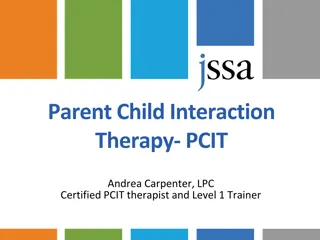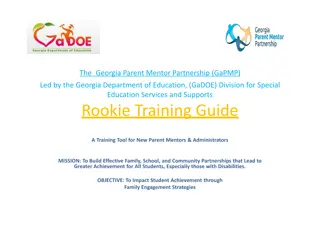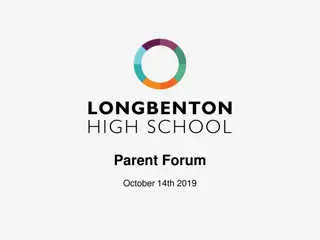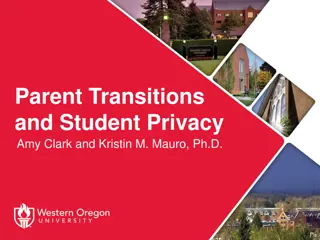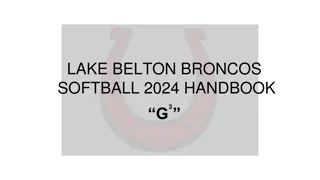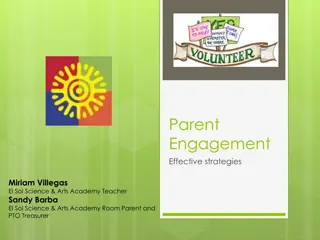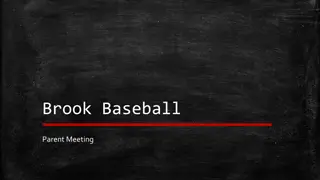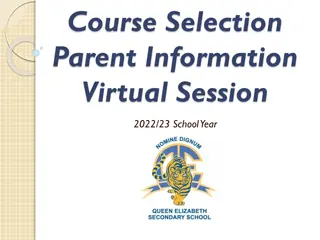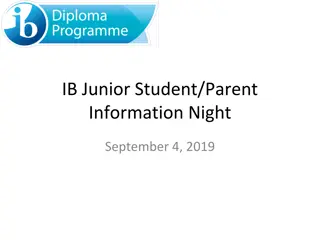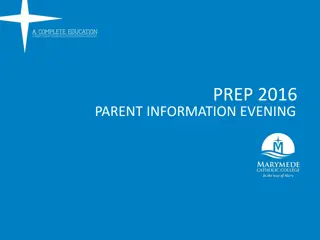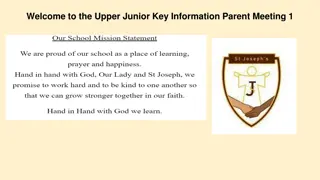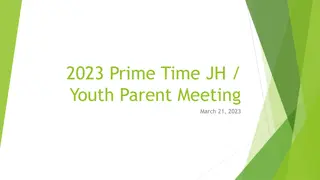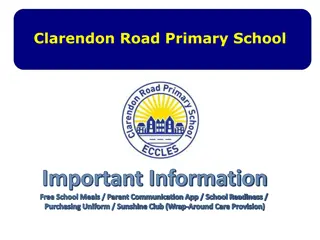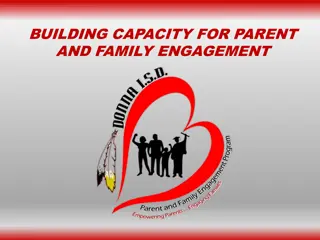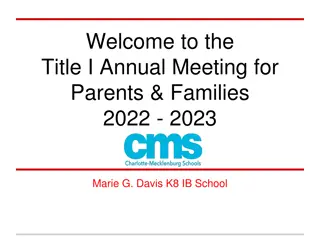PARENT INFORMATION SERIES
Dyslexia is a common learning difficulty that affects reading and writing skills. This informative series by Farida Raj, a Special Educator, provides parents with valuable insights into identifying the signs of dyslexia and practical tips to support their children. By understanding the causes and learning more about dyslexia, parents can better assist their child in overcoming challenges and reaching their full potential. The series offers step-by-step guidance and valuable information for parents seeking to navigate the world of dyslexia with their child.
Download Presentation

Please find below an Image/Link to download the presentation.
The content on the website is provided AS IS for your information and personal use only. It may not be sold, licensed, or shared on other websites without obtaining consent from the author.If you encounter any issues during the download, it is possible that the publisher has removed the file from their server.
You are allowed to download the files provided on this website for personal or commercial use, subject to the condition that they are used lawfully. All files are the property of their respective owners.
The content on the website is provided AS IS for your information and personal use only. It may not be sold, licensed, or shared on other websites without obtaining consent from the author.
E N D
Presentation Transcript
PARENT INFORMATION SERIES DYSLEXIA WAY TO SPOT THE SIGNS UNDERSTANDING DYSLEXIA Step Step 02 04 Step Step 01 03 LEARNING IT S CAUSES TIPS FOR PARENTS Farida Raj, Special Educator
UNDERSTANDING DYSLEXIA LEARNING ITS CAUSES WAY TO SPOT THE SIGNS TIPS FOR PARENTS UNDERSTANDING DYSLEXIA She has excellent vocabulary and has the ability for good oral communication. Her parents had to constantly change her from one school to the other. She was a different young girl since, who avoided eye contact & often mumbled answers. Her written work was not age appropriate & spelt every word when reading from a book. She struggled with blending sounds & had trouble identifying the ending letter sound of each word. Sarah is 8 years old. Her parents are worried about this behavior of hers. A Clinical Psychologist hands out a diagnosis Note : A Special Educator or Dyslexia Therapist can also help with assessment & diagnosis. Sarah has a reading disorder called Dyslexia Farida Raj, Special Educator
UNDERSTANDING DYSLEXIA LEARNING ITS CAUSES WAY TO SPOT THE SIGNS TIPS FOR PARENTS UNDERSTANDING DYSLEXIA Here is a sample of Sarah s writing Farida Raj, Special Educator
UNDERSTANDING DYSLEXIA LEARNING ITS CAUSES WAY TO SPOT THE SIGNS TIPS FOR PARENTS UNDERSTANDING DYSLEXIA READING IS ONE OF THE MOST IMPORTANT SKILLS A CHILD NEEDS TO LEARN WELL. It is the foundation for, BUILDING NEW SKILLS KNOWLEDGE EXPANSION DEVELOPING CREATIVITY For 1 in 10 children reading doesn t come easily. Difficulty with learning to read or spell despite conventional instructions and adequate intelligence is called Dyslexia. Farida Raj, Special Educator
UNDERSTANDING DYSLEXIA LEARNING ITS CAUSES WAY TO SPOT THE SIGNS TIPS FOR PARENTS DO NOT MISTAKE LACK OF READING READINESS TO BE DYSLEXIA READING READINESS IN THE CHILD CAN BE HAMPERED BY SEVERAL FACTORS Reading needs to be developed as a skill from a young age to sharpen reading skills. A child when not exposed to reading due to following reasons can face challenges with reading later in life - Socio-economic reasons which gives the child less access for good reading. Emotional instability. Physical problems with reading (visual defect) Pressure to read at school or home (social pressures that push the child to read more than his/her comfort) Farida Raj, Special Educator
UNDERSTANDING DYSLEXIA LEARNING ITS CAUSES WAY TO SPOT THE SIGNS TIPS FOR PARENTS LEARNING TO READ IS A COMPLEX TASK There is no one specific cause for Dyslexia. Impairment in reading can be due to problems in different body systems. SKILL TO READ REQUIRES COORDINATION OF DIFFERENT BODY SYSTEMS Different body functions are required for reading Eye muscle coordination to follow line of print when reading. Visual memory to retain meaning of words. Grasp of sentence structure & grammar. Categorization & structuring a sentence. Integration of visual cues to memory & specific sounds. There is seldom a single factor that causes Dyslexia, but one factor maybe more dominant than the other. Note : The causes are not comprehensive or conclusive to understand the reason your child has Dyslexia. Farida Raj, Special Educator
UNDERSTANDING DYSLEXIA LEARNING ITS CAUSES WAY TO SPOT THE SIGNS TIPS FOR PARENTS WAY TO SPOT THE SIGNS OF DYSLEXIA DYSLEXIA CAN BE DIVIDED INTO THREE CATEGORIES DEEP DYSLEXIA VISUAL DYSLEXIA It is marked by Reversal of whole word/syllable/letters e.g. now/won Substitution of word e.g. house/home Addition of sounds e.g. isschool/school Omission of letters, syllables, words e.g. sed/said AUDITORY DYSLEXIA It is marked by Having difficulty processing what has been said to the child. Inability to distinguish subtle sound differences in words e.g. bit/bet, pig/peg Trouble filtering out external sounds It is marked by a combination of Visual & Auditory Dyslexia. It arises due to the child s short memory span & difficulty in interpreting visual images. Often a child with Auditory Dyslexia becomes tense or hyperactive in a noisy room. Farida Raj, Special Educator
UNDERSTANDING DYSLEXIA LEARNING ITS CAUSES WAY TO SPOT THE SIGNS TIPS FOR PARENTS WAY TO SPOT THE SIGNS OF DYSLEXIA Common signs of Dyslexia - Poor reading comprehension Trouble expressing verbally Poor spelling Trouble identifying individual words Difficulty expressing thoughts in a written format Difficulty following directions Confusions about directions in space & time (e.g. left from right ; up and down) May see words as distorted or blurred. Omission of letters, syllables, words or word endings (e.g. sed/said) Addition of sounds or words in sentences (e.g. ischool/school) Substitution of words or sounds in sentences (e.g. home/house ; isecream/icecream) Mispronouncing words (e.g. joo/zoo) Note : a word of caution- culturally some sounds are pronounced differently like, sh as s in ischool for school. Wrong pronunciation by a teacher is also picked up by children. Exercise a word of caution before mistaking cultural differences in pronunciation as a sign of Dyslexia.] Reversing the whole word or syllable (e.g. cat/tac ; now/won) Changing of order of words in a sentence (e.g. I like to dance/dance like I to) Ignore punctuation Difficulty with handwriting Loosing the sentence when reading out aloud. Farida Raj, Special Educator
UNDERSTANDING DYSLEXIA LEARNING ITS CAUSES WAY TO SPOT THE SIGNS TIPS FOR PARENTS TIPS FOR PARENTS EDUCATE YOURSELF & TAKE CORRECTIVE STEPS Difficulty to read can range from minor to severe. When minor problems in reading occur and go unrecognized, the challenges in reading add up and go onto becoming severe. Hence, prompt assessment is recommended. Regular testing, monthly or quarterly using informal measures to determine progress in reading and spelling is needed. This is critical to understand if there is growth or if extra intervention is needed. Ask your special educator of ways to help you determine progress of your child at home. Remedial teaching in letter-sound association, sound blending & training in visual perception can help the child perform better. Farida Raj, Special Educator
UNDERSTANDING DYSLEXIA LEARNING ITS CAUSES WAY TO SPOT THE SIGNS TIPS FOR PARENTS TIPS FOR PARENTS BUILDING PHONEMIC AWARENESS Reading skill requires three main areas to be well developed 1. Phonics(decoding) 2. Comprehension 3. Speed Decoding a sentence into separate components is an important skill. If a child lacks this skill he/she will rely on his/her memory to deduce words. Phonics helps the child achieve this without relying only on the power of memory. Phonics is a method to teach and pronounce a word by learning the phonetic value of letters or syllables. E.g. a as in apple ; p as in pot . Majority of children with Dyslexia have a deficit in phonology (understanding that speech is made up of individual sounds). Working on building phonemic awareness, teaching sound-symbol correspondence can help build reading skills in children with Dyslexia. Farida Raj, Special Educator
This content has been developed in collaboration with Remedial & Special Educator Ms.Farida Raj. It has been adapted from her book ''Breaking Through" - A Hand Book for Teachers and Parents of Children with Learning Difficulties & reproduced here with consent. NAYI DISHA RESOURCE CENTRE Join Us on Facebook Nayi Disha Resource Centre is an online information resource platform that supports families of persons with, Specific Learning Disabilities, Intellectual & Developmental Disabilities. Join Us on Twitter Join Us on Linkedin Visit us at WWW.NAYI-DISHA.ORG



